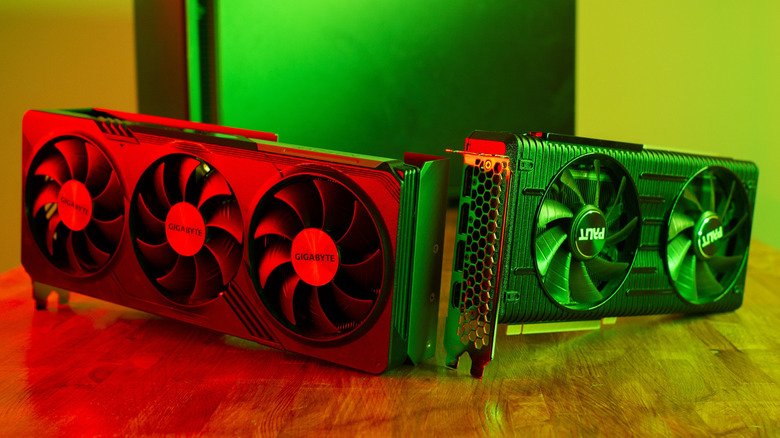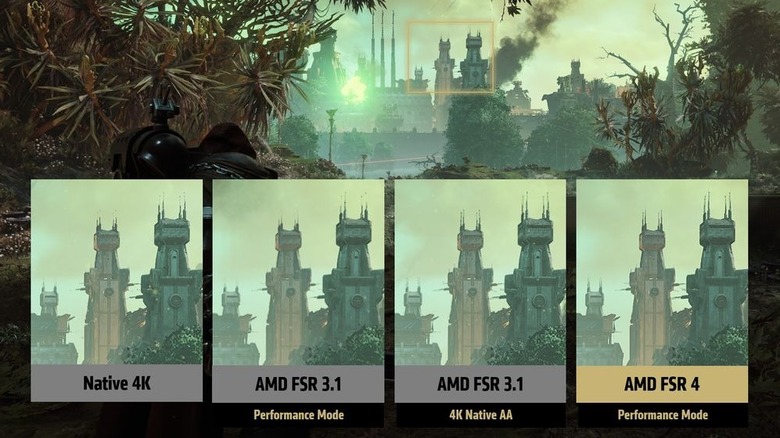Nvidia DLSS 4 Vs. FSR 4: Which Frame Generation Tech Is Better Right Now?
Frame generation and upscaling have quietly become some of the most important features in modern PC gaming. Upscaling turns a lower-resolution render into a higher-resolution output, while frame generation fills the gaps with AI-generated frames to increase smoothness without putting extra strain on the GPU. This trick has single-handedly kept PC gaming playable as visual assets grow heavier each year. Nvidia's DLSS frame generation has held the crown since 2018, and with DLSS 4 — which introduces multi-frame generation — it's better than ever. But with FSR 4, AMD has finally brought something serious to the table.
DLSS 4 is not only newer, but it is also better than FSR 4 in raw image quality and frame generation. Its new transformer model handles texture reconstruction and upscaling better than anything else available right now, without the performance cost. But AMD's FSR 4 is a big leap forward — it consistently outperforms DLSS 3 and gets surprisingly close to DLSS 4 in many scenarios. If you're on a 9000-series Radeon graphics card, FSR 4 is the first time you're not stuck with the short end of the stick. DLSS 4 still has the edge in just about every way, but the days of it being the only good option are officially over.
DLSS 4 is better in every mode, but FSR 4 is no longer a blurry mess
Upscaling gets trickier as the internal resolution drops. At 1080p or 1440p, there's less pixel data for these frame generation technologies to work with, which make visual artifacts and blur more noticeable. Gamers who remember what FSR 3.1 looked like at 1080p with Performance mode know just how bad things used to be. There's no question that DLSS 4 still wins across all upscaling modes — Quality, Balanced, Performance, and Ultra Performance. But FSR 4 has closed the gap at these lower output resolutions, and in some of these upscaling modes, it's a much bigger leap than you might expect.
FSR 4's Balanced and Performance modes now produce clean, stable images that look far more natural than anything AMD has delivered before.
Hardware Unboxed found that hair, foliage, transparencies, and even third-person movement now hold up with surprising consistency. DLSS 4 still preserves more fine detail, especially in fast-moving scenes or high-contrast areas — but the difference isn't huge anymore.
Framerate gains are also similar between DLSS 4 and FSR 4; 30-35% in Quality mode compared to native rendering. DLSS 4's Performance mode, however, edges out FSR 4 by about 6% at 4K resolution. But AMD has closed the 1080 and 1440p gap enough that most Radeon owners can now choose Balanced or Performance mode without sacrificing image output.
DLSS 4 is offered in more games than FSR 4
An upscaler is only useful when a game actually supports it. DLSS 4 is already in a dozen games, and Nvidia's driver-level override means more titles are supporting it without delay. AMD, on the other hand, still hasn't rolled out FSR 4 in key games that were used to promote the tech. This wouldn't be a problem if the gap were small, but it's not. "Cyberpunk 2077" and "Indiana Jones and the Great Circle" both use AMD's last-gen FSR 3.1 upscaler, and still haven't been updated to support native FSR 4.
Even AMD's latest driver update (25.6.1) didn't enable FSR 4 for either game, despite supposedly supporting them. Community and modding solutions like Opticscaler exist solely for this reason because many blockbuster games are still locked to FSR 3.1. Until recently, "Kingdom Come: Deliverance II" was also in the same boat, for weeks after launch, despite being a part of AMD's own FSR 4 marketing.
That leaves a lot of Radeon 9000-series buyers without access to the very feature they paid for. Until AMD streamlines its driver process and starts offering day one FSR 4 support like Nvidia, DLSS 4 will continue to win by simply being more available, even if FSR 4 is finally catching up in performance and quality. For most people, that alone is the deciding factor when choosing between Nvidia and AMD.


